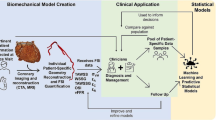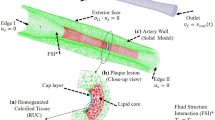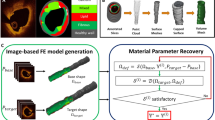Abstract
Myocardial infarction results from the rupture of an atherosclerotic plaque, which occurs in response to both mechanical stress and inflammatory processes. In order experimentally observe flow into atherosclerotic coronary artery morphologies, a novel technique for molding realistic compliant phantom featuring injection-molded inclusions and multiple layers has been developed. This transparent phantom allows for particle image velocimetry (PIV) flow analysis and can supply experimental data to validate computational fluid dynamics algorithms and hypothesis.
Similar content being viewed by others
References
Bale-Glickman, J., Selby, K., Saloner, D. and Savas, O., Experimental flow studies in exact-replica phantoms of atherosclerotic carotid bifurcations under steady input conditions, J. Biomechanics, 125-1 (2003), 38–48.
Benard, N., Coisne, D., Donal, E. and Perrault, R., Experimental study of laminar blood flow through an artery treated by a stent implantation: characterisation of intra-stent wall shear stress, J. Biomechanics, 36 (2003), 991–998.
Berry, J. L., Santamarina, A., Moore, J. E., Roychowdhury, S. and Routh, W. D., Experimental and computational flow evaluation of coronary stents, Ann Biomed Eng., 28-4 (2000), 386–398.
Brown, B. G., Bolson, E. L. and Dodge, H. T., Dynamic mechanisms in human coronary stenosis, Circulation, 70-6 (1984), 917–922.
Brunette, J., Mongrain, R., Cloutier, G., Bertrand, M., Bertrand, O. F. and Tardif, J. C., A novel realistic three-layer phantom for intravascular ultrasound imaging, Int. J. Card Imaging, 17 (2001), 371–381.
Brunette, J., Mongrain, R., L’Allier, P. L., Bertrand, O. F., Grégoire, J. and Tardif, J. C., Intravascular imaging and the biomechanics of plaque rupture, Journal of Clinical Engineering, 28-3 (2003), 163–173.
Felton, C. V., Crook, D., Davies, M. J. and Oliver, M. F., Relation of plaque lipid composition and morphology to the stability of human aortic plaques, Arterioscler Thromb Vasc Biol, 17 (1997), 1337–1345.
Fox, R. W. and McDonald, A. T., Introduction to fluid mechanics; Fifth edition, In: John Wiley & sons, editor. 0-471-12464-8, 1999.
Greenleaf, J. F., Tissue characterization with ultrasound, (1986) CRC Press.
Grigioni, M., Amodeo, A., Daniele, C., D’Avenio, G., Formigari, R. and Di Donato, R. M., Particle image velocimetry analysis of the flow field in total cavopulmonary connection, Artificial organs, 24–12 (2000), 946–952.
Gussenhoven, E. J., Frietman, P., The S. H., van Suylen, R. J., van Egmond, F., Lancée, C. T., Van Urk, H., Roelandt, J., Stijnen, T. and Bom, N., Assessment of medial thinning in atherosclerosis by intravascular ultrasound, Am. J. Cardiol, 68 (1991), 1625–1632.
Gyongyosi, M., Yang, P., Hassan, A., Weidinger, F., Domanovits, H., Laggner, A. and Glogar, D., Coronary risk factors influence plaque morphology in patients with unstable angina, Coronary Artery Dis, 10 (1999), 211–219.
Karino, T. and Motomiya, M., Flow visualization in isolated transparent natural blood vessels, Biorheology, 20 (1983), 119–127.
Kobayashi, S., Tsunoda, D., Fukuzawa, Y., Morikawa, H., Tang, D. and Ku, D. N., Flow and compression in arterial models of stenosis with lipid core, ASME 2003 (Florida), (2003-6), 497–498.
Kullo, I. J., Edwards, W. D. and Schwartz, R. S., Vulnerable plaque: pathobiology and clinical implications, Ann. Intern Med., 129 (1998), 1050–1060.
Lee, R. T., Grodzinsky, A. J., Frank, E. H., Kamm, R. D. and Schoen, J. F., Structure-dependent dynamic mechanical behavior of fibrous caps from human atherosclerotic plaques, Circulation, 83-5 (1991), 1764–1770.
Natarajan, S. and Mokhtarzadeh-Dehghan, M. R., A numerical and experimental study of periodic flow in a model of a corrugated vessel with application to stented arteries, Med. Eng. Phys. 22 (2000), 555–566.
Netter, F. H., The CIBA collection of medical illustrations, (1987), Yonkman F.
Nguyen, T. T., Mongrain, R., Brunette, J., Biadillah, Y., Bertrand, O. F. and Tardif, J. C., A method for matching the refractive index and kinematic viscosity of a blood analog for PIV investigations in hydraulic cardiovascular models, J. Biomechanics, (2003) (accepted).
Ohayon, J., Teppaz, P., Finet, G. and Rioufol, G., In-vivo prediction of human coronary plaque rupture location using intravascular ultrasound and finite element method, Coronary Artery Dis, 12 (2001), 655–663.
Shaaban, A. M. and Duerinck, A. J., Wall shear stress and early atherosclerosis: a review, Am. J. Radiology, 174 (2000), 1657–1665.
Tang, D., Yang, C., Kobayashi, S. and Ku, D. N., Steady flow and wall compression in stenotic arteries: A three-dimensional thick-wall model with fluid-wall interactions, J. Biomed Eng., 1 A.D. 123, 548-557.
Tardif, J. C. and Lee, H. S., What’s new in cardiovascular imaging? Applications of intravascular ultrasound (IVUS) in cardiology, (1998), 133–148, Kluwer academic.
Author information
Authors and Affiliations
Additional information
Mr. Jean Brunette is currently completing his PhD Biomedical Engineering at the Montreal Heart Institute under the University of Montreal Faculty of Medicine program. He did his master degree in Biomedical Engineering at the École Polytechnique of Montreal on intravascular ultrasound imaging. He is presently working on experimental blood dynamics into atherosclerotic coronary arteries and development of cardiovascular devices. Mr. Brunette is currently preparing his postdoctoral industrial fellowship in stent deployment and cryoablation interventions.
Dr. Rosaire Mongrain is an Assistant Professor in Mechanical Engineering at McGill University. He is also a researcher at the Montreal Heart Institute and shares a Biomechanics Laboratory with clinical researchers and basic scientists. He completed his PhD at the École Polytechnique of Montreal in biomedical engineering on blood dynamics and a postdoctoral fellowship at Brigham’s Women Hospital in interventional radiology. Dr. Mongrain research interests include blood flow dynamics, cardiovascular rheology, circulatory disorders and the design and improvement of cardiovascular devices.
Dr. Jean-Claude Tardif is an associate professor of Montreal faculty of medicine at the Montreal Heart Institute, where he also serves as a cardiologist and Director of Research. Dr. Tardif is holder of a chair on atherosclerosis created by the Pfizer pharmaceutical society, Health Research Canada and the University of Montreal. Conducting 40 people within his team, he is specialized into antioxidants and intravascular ultrasound imaging. He wrote numerous articles in prestigious journals like the New England Journal of Medicine and has been stated as one of the most promising researchers of the new generation by the American Time magazine.
Rights and permissions
About this article
Cite this article
Brunette, J., Mongrain, R. & Tardif, J.C. A realistic coronary artery phantom for particle image velocimetry. J Vis 7, 241–248 (2004). https://doi.org/10.1007/BF03181639
Received:
Revised:
Issue Date:
DOI: https://doi.org/10.1007/BF03181639




